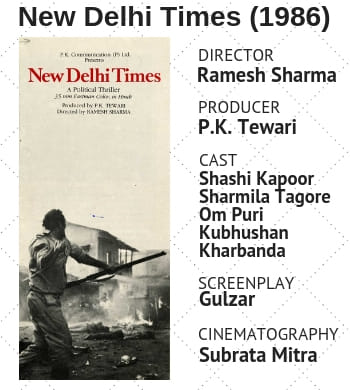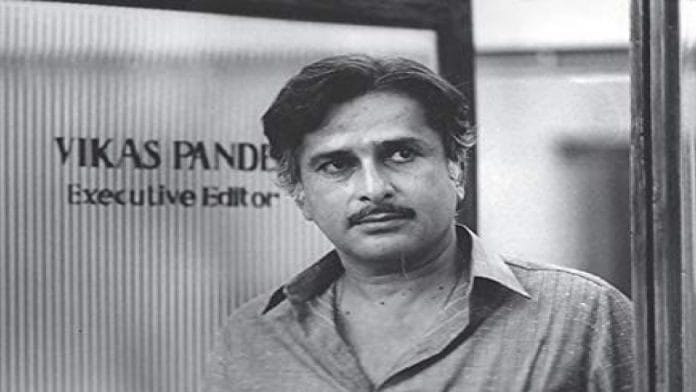Shashi Kapoor won the Dadasaheb Phalke award for 2014 for his contribution to Hindi cinema. His legacy is perceived to be that of a great producer and even greater enabler of cinema that wasn’t mainstream, although not necessarily arthouse.
 But Kapoor wasn’t just a great producer, he was also a versatile actor and, more importantly, made a unique and lasting contribution to the city of Mumbai – in the form of Prithvi Theatre. In 1986, he won his first national award as an actor for his performance in Ramesh Sharma’s New Delhi Times.
But Kapoor wasn’t just a great producer, he was also a versatile actor and, more importantly, made a unique and lasting contribution to the city of Mumbai – in the form of Prithvi Theatre. In 1986, he won his first national award as an actor for his performance in Ramesh Sharma’s New Delhi Times.
Kapoor’s 81st birth anniversary will be celebrated Monday.
The Hindi film industry hasn’t seen too many films set in the world of journalism — possibly because filmmakers in Mumbai like to dumb down and journalism, by definition, doesn’t fit in that mould.
New Delhi Times, in that sense, is a complete outlier. It is a pure genre film and doesn’t compromise on its integrity at all. It takes a subject at hand — political corruption — and deals with it in a fairly convincing way with enough evidence of credible research. One can presume that it was the handiwork of Gulzar who wrote the film’s screenplay.
Also read: I always had a soft spot for Shashi Kapoor, I remember his eyelashes: Sharmila Tagore
The film begins with a political murder in Ghaziabad. To reach the bottom of what’s actually a conspiracy, Vikas Pande, executive editor of the titular ‘New Delhi Times’, starts off with an investigation in a hooch tragedy that takes place due to criminal negligence.
(Curiously, 33 years on, hundreds of people are still dying in hooch tragedies across India, with almost zero political accountability.)
Pande, a middle-aged upright editor who stays in office till late in the night, away from his lawyer wife Nisha (Sharmila Tagore), has an allegiance only to truth. He could’ve been a banal character with no complexity but the film surrounds him with challenging people — like the photographer Anwar, played by a young M.K. Raina.
Eyeing a story in the quick political rise of MLA Ajay Singh, who is threatening the chair of chief minister Chaturvedi, Pande travels to Ghaziabad where riots have broken out. In a tricky situation, he saves Anwar who faces the risk of an attack in the middle of the riots.
Also read: No jobs then, no jobs now: Gulzar’s 1971 film Mere Apne still rings an unfortunate bell
When they reach the hotel room, Anwar says “Yahan aaya to pata chala dange ho rahe hain, mazaa aa gaya… Bas camera leke toot pada. (On reaching here, I found out that riots are happening. I was thrilled. I just jumped at it.)”
Pande asks, “Tumhe riots me mazaa aata hai? (You are thrilled by riots?)”
Anwar says, “Ama yaar tum samajh gaye na main na kya keh raha hun. Tumhe ek achchi story mil gayi, mujhe kuch achche photographs. Bas. (You understood exactly what I was saying. You found a good story. I clicked some good photographs. What else.)”
In a succinct scene, the filmmaker is able to convey the fundamental duality that plagues all journalists — the thrill of chasing a ‘good story’ that is also a human tragedy, or failure.
Pande, who in Nisha’s words “doesn’t know when to stop”, continues to pursue the story further.
An eventual lucky break comes through Nisha, who is approached by an old man looking for his missing daughter.
Pande sticks to Ajay Singh, and even confronts him, in the hope that that’s where the story lies. But the truth strikes from unexpected directions.
This well-designed atmospheric political thriller isn’t easily available. The only ‘bad quality’ print that floated on the internet for years is not available on YouTube now. But it’s a film worth chasing.
Director Ramesh Sharma displayed no signs of being overwhelmed with what’s a delicate subject to deal with — it could have easily become preachy (like the terrible 2010’s Rann) or unconvincing (like the 1988’s New Delhi).
In New Delhi Times, Sharma and Gulzar not only paint an overall picture of what politician-media nexus can be like, but they also introduce Indian viewers to a world they are largely unacquainted with. Unlike pretty much every single mainstream film made in Mumbai, it even understood the kind of news that makes it to the front page — no, they’re never stories about film stars.
There are also journalistic techniques, like editing and news gathering and printing, on display for a peek into the world of scribes.
Also read: Baharen Phir Bhi Aayengi was a 1966 film, but it speaks to the crisis in journalism today
That the makers do all of this with a relatively modern style of filmmaking — shot by the legendary Subrata Mitra and edited by the indubitable Renu Saluja — is testament to their craft, which was recognised by the National Film Awards in several categories.
Kapoor picked a part that was unusual for stars of his stature and, as he often did, lent a lot of dignity and credibility to Pande. New Delhi Times remains a milestone in not just his career, but also in the history of Hindi films — it had the spirit of truth in it, and that’s what all journalism ought to be.
(This article has been updated to remove a reference to a film that was wrongly attributed to director Ramesh Sharma)







Aaj bhi, Ravish Kumarji hain na …
Well said! But the tragedy is, there are far too few of his ilk now. But increasingly, and especially after the events of last few weeks, this has started to look like a loosing battle.